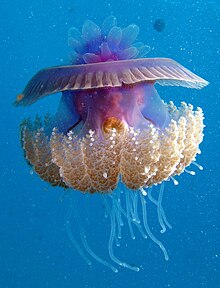
Back Cephea cephea Bulgarian Cephea cephea Catalan Cephea cephea CEB Cephea cephea Czech Cephea cephea French Cephea cephea Dutch Cephea cephea Swedish Cephea cephea WAR
| Cephea cephea | |
|---|---|

| |
| Scientific classification | |
| Domain: | Eukaryota |
| Kingdom: | Animalia |
| Phylum: | Cnidaria |
| Class: | Scyphozoa |
| Order: | Rhizostomeae |
| Family: | Cepheidae |
| Genus: | Cephea |
| Species: | C. cephea
|
| Binomial name | |
| Cephea cephea Forsskål, 1775
| |
| Synonyms | |
| |
Cephea cephea, also known as the crown jellyfish, or cauliflower jellyfish, is a species of jellyfish in the family Cepheidae.[1] It occurs in the tropical waters of the western Indo-Pacific to Northern Australia. The species was first described by Peter Forsskål in 1775 and originally given the name Medusa cephea. It inhabits the pelagic zone of tropical and sub-tropical waters and is most commonly found in the Indo-West Pacific, eastern Atlantic and the Red Sea. Although this species is among the most venomous jellyfish, it is not harmful to humans and is eaten as a delicacy and used for medical purposes in China and Japan. The species can achieve a diameter of up to 60 cm.
- ^ Collins, A. G.; Jarms, G.; Morandini, A. C. (2021). "World List of Scyphozoa. Cephea cephea (Forskål, 1775)". WoRMS. World Register of Marine Species. Retrieved 5 April 2021.
{{cite web}}: CS1 maint: multiple names: authors list (link)